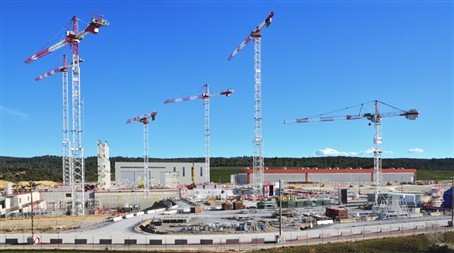F4E and Ferrovial collaborate to heat up ITER’s mega plasma


The progress of the civil engineering works on the ITER construction site is visible. Key buildings like the Tokamak complex, where the biggest-ever fusion device will be located, and the Assembly Hall, where hundreds of bulky high-tech components will be assembled in order to be fitted correctly in the ITER machine, are constantly evolving. A new chapter is about to begin on the site with the development of infrastructure that will supply ITER and its different systems with electricity.
Two new substations where high voltage electrical networks, including seven transformers, will be installed in order to supply the ITER machine and some of its systems with power will be delivered through a contract signed between F4E, the EU organisation managing Europe’s contribution to ITER, and Ferrovial Agroman. The works are expected to be completed in six years and will reach a value of approximately 30 million EUR. The design, installation, commissioning and maintenance of the electrical networks, combined with civil engineering works of the buildings that will host the electrical devices, will materialise through this contract. For Pietro Barabaschi, F4E Acting Director, “this contract sets the foundations of the power supply that ITER will require in order to demonstrate the viability of fusion energy at this scale”. Alejandro de la Joya, CEO of Ferrovial Agroman, explained that “thanks to this contract Ferrovial Agroman has the opportunity to be further involved in ITER and establish itself as one of the most committed contractors. We are extremely proud to be part of the most ambitious international energy project”.
The ITER site:
The size of the ITER platform is 42 hectares and Europe is the party responsible for the delivery of the 39 buildings and areas that the ITER platform will host. Currently, the personnel directly involved in construction counts 400 people. One of the key challenges will be to accommodate the needs of the rapidly growing workforce and to guarantee an optimal use of space to the different companies operating on the ground, in order to carry out the construction of all infrastructures in parallel and on time.
The ITER electrical network:
A total power of 1200 MVA will be made available through a Pulsed Power Electrical Network (PPEN) and a Steady-State Electrical Network (SSEN). For example, the AC/DC converters, the Heating and Current Drive systems, and the Reactive Power Compensation will be supplied through the PPEN, whose high voltage components will come from China. Thanks to this electrical network, the ITER plasma will be heated and the powerful superconductive magnets will operate in order to confine it. Meanwhile, the major consumers of the SSEN, whose high voltage components will come from the US, will supply with power the cryogenic and cooling water systems, the tritium plant and the general infrastructures. This network will provide the power needed to generate the low temperatures for some of the components in the machine.
The scope of the contract:
Through this contact, apart from the electrical equipment that will be provided such as substations containing circuit breakers, lines, disconnectors, transformers, and medium and low voltage load centres, it is envisaged that infrastructure works will be carried out and one building will be constructed.
Background information
Press release
Europe starts developing the electricity infrastructure that will heat up ITER’s mega plasma
(EN)/(ES)
MEMO
Europe starts developing the electricity infrastructure that will heat up ITER’s mega plasma
(EN)/(ES)